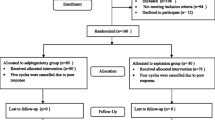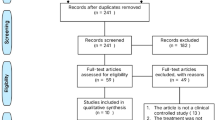Abstract
Background
This was a prospective randomized controlled trial in 200 cases presented with endometrial cavity fluid at the day of oocyte retrieval at a private fertility center from 2013 to 2021. The cases were randomized at day of ovum pickup into 2 groups: Group 1 (control group) (n = 100): conventional management with follow-up and reassessment by transvaginal ultrasound on day 5. Group 2 (interventional group) (n = 100): aspiration of the fluid was done and cases were given diosmin 500 mg 3 times per day till reassessment at embryo transfer day. In both groups, we proceeded with fresh embryo transfer if no fluid is present on day 5 or freeze-all policy if persistent fluid was detected.
Results
Endometrial fluid on the 5th day was significantly higher in the control group (28.0%) than in the interventional group (6.0%) (P < 0.001). Regarding pregnancy rate, although being higher in the interventional group (54.3% vs 50.0%), the difference was not statistically significant (P = 0.5). It was found that the intervention was associated with risk reduction of endometrial fluid (OR = 0.168, 95% CI = 0.065–0.429, P < 0.001.
Conclusion
Aspiration of endometrial cavity fluid with diosmin intake increased the likelihood of fresh embryo transfer and with a slightly better pregnancy rate compared to conservative management.
Clinical trial number: NCT02158000, Date of registration: 6/6/2014, Date of initial enrollment (first patient recruiting): 1/11/2014, URL: https://clinicaltrials.gov/ct2/show/NCT02158000.


Similar content being viewed by others
Data Availability
according to the journal policy.
References
Malchau SS, Henningsen AA, Loft A, Rasmussen S, Forman J, Nyboe Andersen A, et al. The long-term prognosis for live birth in couples initiating fertility treatments. Hum Reprod. 2017;32(7):1439–49. https://doi.org/10.1093/humrep/dex096.
De Geyter C, Calhaz-Jorge C, Kupka MS, Wyns C, Mocanu E, Motrenko T, Scaravelli G, Smeenk J, Vidakovic S, Goossens V. European IVF-monitoring Consortium (EIM) for the European Society of Human Reproduction and Embryology (ESHRE). ART in Europe, 2014: results generated from European registries by ESHRE. Hum Reprod. 2018;33:1586–601. https://doi.org/10.1093/humrep/dey242.
Haahr T, Esteves SC, Humaidan P. Poor definition of poor-ovarian response results in misleading clinical recommendations. Hum Reprod. 2018;1(33):979–80. https://doi.org/10.1093/humrep/dey059.
Haahr T, Esteves SC, Humaidan P. Individualized controlled ovarian stimulation in expected poor-responders: an update. Reprod Biol Endocrinol. 2018;16(1):20. https://doi.org/10.1186/s12958-018-0342-1.
Gupta N, Bhandari S, Agrawal P, Ganguly I, Singh A. Effect of endometrial cavity fluid on pregnancy rate of fresh versusfrozen in vitro fertilization cycle. J Hum Reprod Sci. 2017;10(4):288–92.
He RH, Gao HJ, Li YQ, Zhu XM. The associated factors to endometrial cavity fluid and the relevant impact on the IVF/ET outcome. Reprod Biol Endocrinol. 2010;14(8):46. https://doi.org/10.1186/1477-7827-8-46.
Chien LW, Au HK, Xiao J, Tzeng CR. Fluid accumulation within the uterine cavity reduces pregnancy rates in women undergoing IVF. Hum Reprod. 2002;17(2):351–6. https://doi.org/10.1093/humrep/17.2.351.
Akman MA, Erden HF, Bahceci M. Endometrial fluid visualized through ultrasonography during ovarian stimulation in IVF cycles impairs the outcome in tubal factor but not PCOS patients. Hum Reprod. 2005;20(4):906–9. https://doi.org/10.1093/humrep/deh737.
Levi AJ, Segars JH, Miller BT, Leondires MP. Endometrial cavity fluid is associated with poor ovarian response and increased cancellation rates in ART cycles. Hum Reprod. 2001;16(12):2610–5. https://doi.org/10.1093/humrep/16.12.2610.
Sharara FI, McClamrock FI. Endometrial fluid collection in women with hydrosalpinx after human chorionic gonadotrophin administration: a report of two cases and implication for management. Hum Reprod. 1997;12(12):2816–9. https://doi.org/10.1093/humrep/12.12.2816.
Sharara FI, Prough SG. Endometrial fluid collection in women with PCOS undergoing ovarian stimulation for IVF: a report of four cases. J Reprod Med. 1999;44(3):299–302.
Drbohlav P, Halkova E, Masata J, et al. The effect of endometrial infection on embryo implantation in the IVF and ET program. Ceska Gynekol. 1998;1998(63):181–5.
Lee RK, Yu SL, Chih YF, Tsai YC, Lin MH, Hwu YM, et al. Effect of endometrial cavity fluid on clinical pregnancy rate in tubal embryo transfer (TET). J Assist Reprod Genet. 2006;23:229–34. https://doi.org/10.1007/s10815-006-9035-3.
Liu S, Shi L, Shi J. Impact of endometrial cavity fluid on assisted reproductive technology outcomes. Int J Gynecol Obstet. 2016;132:278–83. https://doi.org/10.1016/j.ijgo.2015.07.037.
Gürgan T, Urman B, Aksu T, Yarali H, Kisnisci HA. Fluid accumulation in the uterine cavity due to obstruction of the endocervical canal in a patient undergoing in vitro fertilization and embryo transfer. J Assist Reprod Genet. 1993;10(6):442–4. https://doi.org/10.1007/BF01228097.
Andersen AN, Yue Z, Meng FJ, Petersen K. Low implantation rate after in-vitrofertilization in patients with hydrosalpinges diagnosed by ultrasonography. Hum Reprod. 1994;9(10):1935–9.
Bloechle M, Schreiner T, Lisse K. Recurrence of hydrosalpinges after transvaginal aspiration of tubal fluid in an IVF cycle with development of a serometra. Hum Reprod. 1997;12(4):703–5. https://doi.org/10.1093/oxfordjournals.humrep.a138362.
Mansour RT, Aboulghar MA, Serour GI, Riad R. Fluid accumulation of the uterine cavity before embryo transfer: a possible hindrance for implantation. J In Vitro Fertil Embryo Transf. 1991;8:157–9. https://doi.org/10.1007/BF01131707.
Silambarasan T, Raja B. Diosmin, a bioflavonoid reverses alterations in blood pressure, nitric oxide, lipid peroxides and antioxidant status in DOCA-salt induced hypertensive rats. Eur J Pharmacol. 2012;679(1–3):81–9. https://doi.org/10.1016/j.ejphar.2011.12.040.
Bogucka-Kocka A, Woźniak M, Feldo M, Kockic J, Szewczyk K. Diosmin–isolation techniques, determination in plant material and pharmaceutical formulations, and clinical use. Nat Prod Commun. 2013;8(4):545–50.
Senthamizhselvan O, Manivannan J, Silambarasan T, Raja B. Diosmin pretreatment improves cardiac function and suppresses oxidative stress in rat heart after ischemia/reperfusion. Eur J Pharmacol. 2014;736:131–7. https://doi.org/10.1016/j.ejphar.2014.04.026.
Shalkami AS, Hassan MI, Bakr AG. Anti-inflammatory, antioxidant and anti-apoptotic activity of diosmin in acetic acid-induced ulcerative colitis. Hum Exp Toxicol. 2018;37(1):78–86.
Ramelet AA. Pharmacologic aspects of a phlebotropic drug in CVI associated edema. Angiology. 2000;51(1):19–23. https://doi.org/10.1177/000331970005100105.
Manthey JA. Biological properties of flavonoids pertaining to inflammation. Microcirculation. 2000;7(6 pt 2):S29–34.
Labrid C. Pharmacologic properties of Daflon 500 mg. Angiology. 1994;45(6):524–30.
Imam F, Al-Harbi NO, Al-Harbi MM, et al. Diosmin down regulates the expression of T cell receptors, proinflammatory cytokines and NF-κB activation against LPS induced acute lung injury in mice. Pharmacol Res. 2015;102:1–11. https://doi.org/10.1016/j.phrs.2015.09.001.
Nikolettos N, Asimakopoulos B, Vakalopoulos I, Simopoulou M. Endometrial fluid accumulation during controlled ovarian stimulation for ICSI treatment. A report of three cases. Case Rep Clin Exp Obstet Gynecol. 2002;29(4):290–2.
Griffiths AN, Watermeyer SR, Klentzeris LD. Fluid within the endometrial cavity in an IVF cycle: a novel approach to its management. J Assist Reprod Genet. 2002;19(6):298–301. https://doi.org/10.1023/A:1015785431828.
He RH, Zhu XM. How to deal with fluid in the endometrial cavity during assisted reproductive techniques. Curr Opin Obstet Gynecol. 2011;23(3):190–4. https://doi.org/10.1097/GCO.0b013e3283468b94.
Zhang WX, Cao LB, Zhao Y, Li J, Li BF, Lv JN, Yan L, Ma JL. Endometrial cavity fluid is associated with deleterious pregnancy outcomes in patients undergoing in vitro fertilization/intracytoplasmic sperm injection: a retrospective cohort study. Ann Transl Med. 2021;9(1):9. https://doi.org/10.21037/atm-20-3623.
Van der Gaast MH, Beier-Hellwig K, Fauser BC, Beier HM, Macklon NS. Endometrial secretion aspiration prior to embryo transfer does not reduce implantation rates. Reprod Biomed Online. 2003;7(1):105–9. https://doi.org/10.1016/s1472-6483(10)61737-3.
Al-Hussaini TK, Shaaban OM. Aspiration of endometrial cavity fluid at the time of egg collection. Middle East Fertil Soc J. 2018;23(4):354–6. https://doi.org/10.1016/j.mefs.2018.04.012.
Acknowledgements
We would like to thank our dedicated lab directors. Dr. Waleed Abdel lateef & Dr. Sahar Eissa for their continuous support.
Funding
This research did not receive any specific Grant from funding agencies in the public, commercial, or not-for-profit sectors.
Author information
Authors and Affiliations
Contributions
The authors have explained the intervention to the patients and had their consent. No personal information of the patients or details have been revealed. The authors have equally contributed in collecting the data and writing the research work.
Corresponding author
Ethics declarations
Conflict of interest
The authors declare that they have no conflict of interest.
Ethics Approval and Consent to Participate
The authors are accountable for all aspects of the work in ensuring that questions related to the accuracy or integrity of any part of the work are appropriately investigated and resolved: The study was approved by the institutional review board of the fertility center (Hawaa—001-0056) at 5/6/2013. All procedures performed in this study involving human participants were in accordance with the Declaration of Helsinki (as revised in 2013).
Informed Consent
The authors have explained the intervention to the patients and had their written consent and no personal information of the patients or details have been revealed.
Additional information
Publisher's Note
Springer Nature remains neutral with regard to jurisdictional claims in published maps and institutional affiliations.
Ahmed Samy Saad is an Assistant Professor; Khalid Abd Aziz Mohamed is an Assistant Professor.
Rights and permissions
Springer Nature or its licensor (e.g. a society or other partner) holds exclusive rights to this article under a publishing agreement with the author(s) or other rightsholder(s); author self-archiving of the accepted manuscript version of this article is solely governed by the terms of such publishing agreement and applicable law.
About this article
Cite this article
Saad, A.S., Mohamed, K.A.A. Aspiration with Diosmin Intake in Endometrial Cavity Fluid Accumulation in ART Cycles: A Randomized Controlled Trial. J Obstet Gynecol India 73, 336–342 (2023). https://doi.org/10.1007/s13224-023-01791-7
Received:
Accepted:
Published:
Issue Date:
DOI: https://doi.org/10.1007/s13224-023-01791-7




